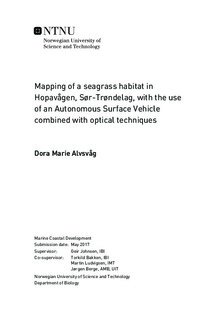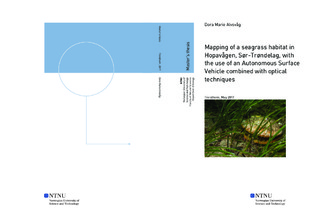| dc.description.abstract | Mapping and monitoring of marine habitats are important for proper management and decision making. However, shallow coastal habitats (0 5 meters depth) are largely under-sampled in time and space. Knowledge about morphology, ecology and biodiversity regarding these areas is therefore strongly needed. Advances in technology have provided a large range of instrument bearing platforms that are useful for mapping and monitoring purposes. This includes underwater robotics, such as remotely operated vehicles (ROV s) and autonomous underwater vehicles (AUV s). As operation of these platforms may be both expensive and impractical for shallow-water mapping, the use of an autonomous surface vehicle (ASV) is a new and promising approach.
This thesis aims at mapping a seagrass habitat by combining non-destructive optical techniques with new technology, in order to evaluate the potential of new mapping approaches, revealing the challenges that may occur and suggesting performance improvements that is required for optimal results in the future.
A shallow seagrass habitat located in a semi-enclosed lagoon (Hopavågen, Sør-Trøndelag) was mapped by combining several optical techniques with the use of an ASV, including both qualitative and quantitative measurements. The study consisted of habitat description (underwater photography), seagrass distribution (video transect, ASV), coverage estimates (square analysis), physiological measurements (PAM and HPLC, see Abbreviations), and studies of morphology and epigrowth (physical measurements and species identification). The findings indicated a patchy and biodiverse eelgrass (Zostera marina) meadow. The overall physiological status of the plants was found to be relatively high, but differences in maximum photosynthetic quantum yield of photosystem II (PSII) and pigment content were observed for different months and leaf locations. Changes in light availability as a result of organisms growing on the leaves (epigrowth) are likely to be the main cause of variation.
The imagery provided by the ASV ( JetYak developed by WHOI and NTNU, see Abbreviations) was combined into a photo mosaic, indicating the seagrass distribution in the area. It was possible to discriminate between the seagrass and the seafloor, but the level of detail was restricted by the image quality. For increased data quality in future mapping, improved speed and stability control (pitch, roll and yaw) of the ASV, weather conditions, availability of light for image illumination, depth and camera specifications should be taken into consideration. Overall, the ASV seems to be a suitable platform for mapping of shallow areas, but further developments indicated above are required for optimal use in the future. | |

